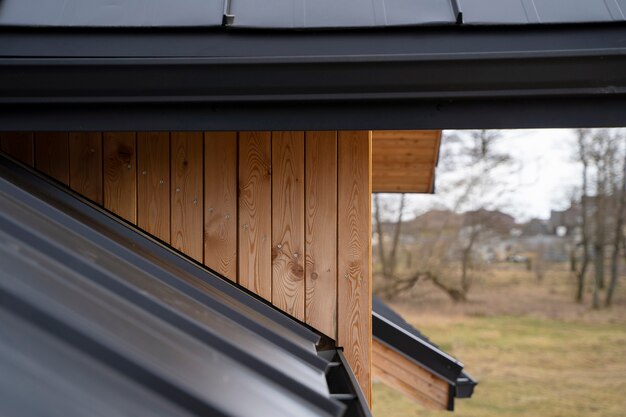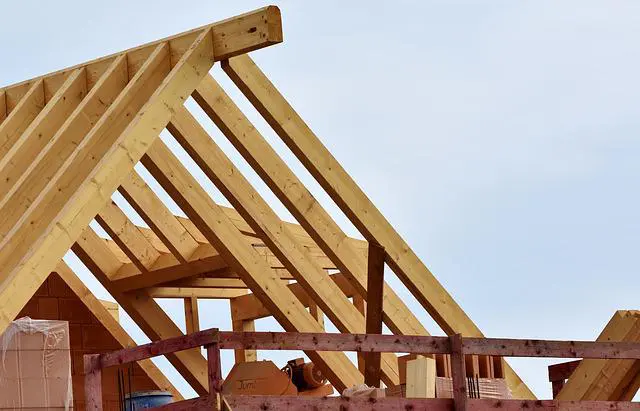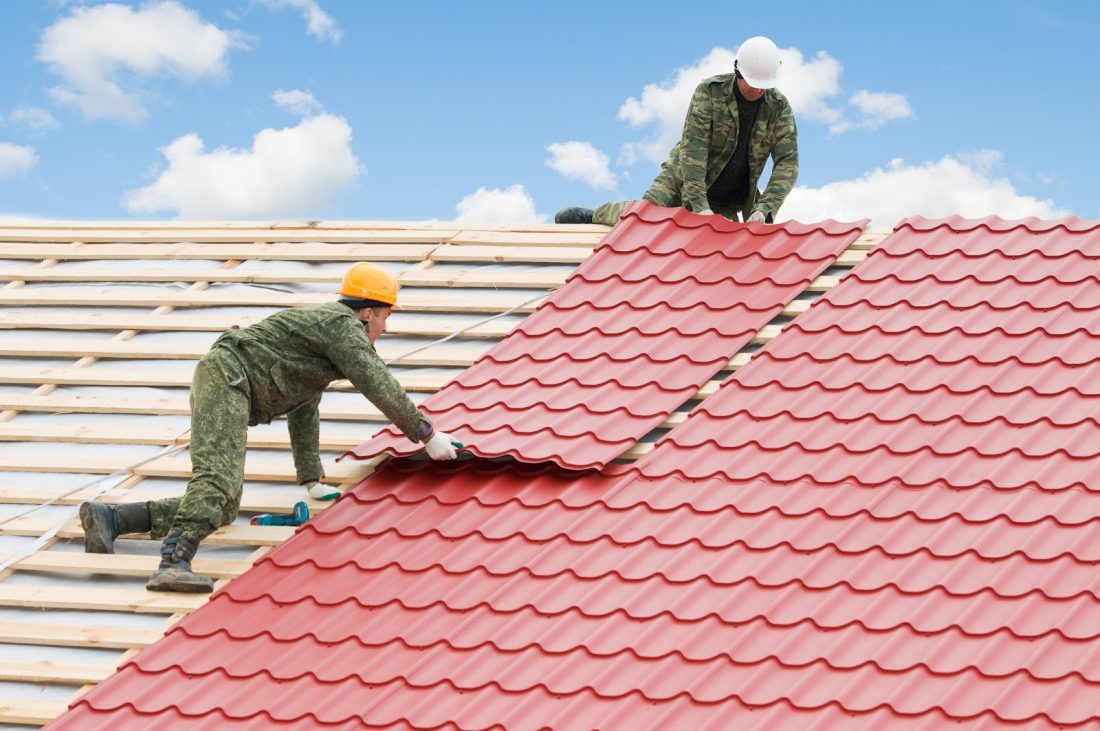Wood shingles are a traditional roofing material known for their natural appearance. They offer an aesthetic charm and are commonly made from cedar, redwood, or pine.
Wood shingles have been a top choice for roofing for centuries, esteemed for their natural beauty and durability when properly maintained. Crafted from split logs, these shingles blend effortlessly with rustic environments and can also enhance the character of more modern homes.
They provide good insulation properties and can last up to 30 years with the right care. For homeowners seeking an eco-friendly option, wood shingles can be treated to improve their resistance to fire and decay, making them a more sustainable choice. As with any roofing material, professional installation and regular maintenance are crucial to maximizing the lifespan and performance of a wood shingle roof.

Introduction To Wood Shingles
From rustic cabins nestled in the verdant countryside to elegant homes gracing modern urban landscapes, wood shingle roofs have an undeniable charm that has withstood the test of time. These slender pieces of natural wood are not only known for their beauty but also for their impressive durability when properly maintained. As a nod to tradition blended with contemporary aesthetic appeal, wood shingles offer a unique roofing solution that holds a special place in the architectural history.
Understanding Wood Shingles And Their Historical Use
Wood shingles have been a premier choice for roofing materials going back centuries. They are traditionally hand-split from logs, which allows for a rustic, textured appearance that contemporary homeowners still find desirable. Historically, these shingles were favored for their ready availability and the ease with which they could be produced by hand—a craft that required nothing more than an ax and a skilled tradesman. Their popularity soared owing to their natural insulation properties and their capacity to weather over time to an attractive, silvery gray.
Types Of Wood Used For Shingles And Their Characteristics
The selection of wood for shingles is vital in determining their lifespan and resilience against the elements. Here are some commonly used woods:
- Cedar: Known for its natural preservatives that resist moisture, decay, and insect damage. Cedar also has a stunning, rich grain that becomes more prominent with age.
- Redwood: Similar to cedar in terms of its resistance qualities, redwood also offers a unique color that many find appealing for its warmth and vibrancy.
- Pine: Often chosen for its abundance and cost-effectiveness, pine can provide a good middle ground between durability and affordability.
- Cypress: Valued for its durability and resistance to harsh weather conditions, cypress is a premium choice amongst wood shingle materials.
Each kind of wood brings its own set of characteristics to the table—be it the natural resilience, grain pattern, or the ability to blend seamlessly with various architectural styles. The choice often boils down to climatic compatibility, aesthetic preferences, and budget considerations.
Eco-friendly Benefits Of Wood Shingle Roofs
Renewable Resource: The Sustainability Of Wood
Wood shingles harness the power of nature, as they are crafted from a renewable resource – timber. Unlike other roofing materials, wood shingles are produced from trees that can be replanted and regrown, aligning with sustainable forest management practices. This means that the material for wood shingle roofs contributes to a continuous cycle that benefits the environment.
- Sustainable forestry practices ensure that for every tree harvested, more are planted to maintain balance.
- Certification programs like the Forest Stewardship Council (FSC) guarantee that wood shingles come from responsibly managed forests.
- Wood’s natural properties make it adaptable to various climates, promoting longevity and reducing the need for frequent replacements.
Energy Efficiency: Insulation Benefits Of Wood Shingles
Wood shingles excel in thermal performance, providing natural insulation that can keep homes cozy during the winter and cool in the summer. This insulative quality results in reduced reliance on heating and cooling systems, leading to lower energy consumption. Not only does this benefit the planet by reducing greenhouse gas emissions, but it also translates into substantial savings on utility bills for homeowners.
| Season | Benefit |
|---|---|
| Winter | Wood retains heat, reducing heating costs. |
| Summer | Reflects heat, minimizing air conditioning use. |
Biodegradable And Recyclable Nature Of Wood Shingles
At the end of their lifecycle, wood shingles demonstrate eco-friendly disposability. These materials are biodegradable, meaning they can decompose naturally without leaving harmful residue in the environment. In addition, wood shingles can be recycled into mulch, wood chips, or even repurposed for other building projects. Their disposability aligns perfectly with a zero-waste ideology, contributing significantly to the reduction of construction waste in landfills.
Low Carbon Footprint In Manufacturing And Transportation
The production and transportation of wood shingles typically require less energy, further enhancing their status as an eco-friendly roofing material. Since wood is lighter than many alternatives, it incurs a lower carbon footprint during shipping. Moreover, the manufacturing process of wood shingles is less energy-intensive compared to that of asphalt shingles or metal roofing, resulting in less environmental impact from start to finish.
- Energy savings in manufacturing – less processing means reduced energy use and emissions.
- Efficient transportation – lighter weight allows for more shingles per shipment, minimizing transportation emissions.

Aesthetic And Functional Advantages Of Wood Shingles
Wood shingles are a coveted roofing material that seamlessly combines beauty with performance. Their timeless charm and reliable functionality have earned them a distinguished place in construction. Below, we delve into the aesthetic and functional advantages of wood shingles, detailing why they might be the perfect choice for your roofing needs.
Natural Beauty: The Unique Look Of Wood Shingles
Wood shingles offer a distinctive look that no other roofing material can replicate. Each shingle weathers naturally over time, resulting in a stunning, organic appearance that blends harmoniously with the surrounding environment. Their natural grain patterns and subtle color variations create a warm, rustic aesthetic that is both inviting and elegant.
Versatility: Adapting Wood Shingles To Various Architectural Styles
Wood shingles adapt effortlessly to a wide range of architectural designs from traditional to contemporary. This versatility allows them to complement and enhance the overall look of any home. Whether it is a quaint cottage or a modern masterpiece, wood shingles can be cut and styled to fit the specific architectural nuances of any property.
Durability And Life Span Of Wood Shingles
Contrary to popular belief, wood shingles are incredibly durable. When treated properly, they can withstand harsh weather conditions, including strong winds, hail, and heavy rains. Additionally, certain types of wood shingles have natural oils that make them resistant to rot, insects, and decay. With proper installation and regular upkeep, wood shingle roofs can last up to 30 years, making them a reliable and long-lasting roofing option.
Ease Of Repair And Maintenance For Long-term Performance
One of the practical benefits of wood shingles is their ease of repair and maintenance. Unlike other roofing materials that may require full replacement when damaged, individual wood shingles can be replaced as needed. This focused approach to repairs not only saves time but also reduces overall maintenance costs. To ensure long-term performance, regular cleaning, and treating with preservatives and fungicides are recommended, which will protect the wood from environmental wear and tear.
Challenges And Considerations
Choosing wood shingles for your home’s roof comes with its own set of unique challenges and considerations. While the aesthetic appeal of natural wood is undeniable, homeowners need to understand everything from installation nuances to long-term upkeep. Careful planning and analysis can help you navigate these potential complications, ensuring your wood-shingled roof is not only beautiful but durable and practical too. Let’s delve into the key factors that can impact your decision and satisfaction with a wooden shingle roof.
Installation Considerations: Expertise Required For Wood Shingles
Wood shingle roofing installation is not a beginner DIY project. Success hinges on specialized skills and precision. Here’s why expertise is crucial:
- Each shingle must be carefully aligned and spaced to enable proper drainage and ventilation.
- Custom shaping may be necessary to fit complex roof lines and structures.
- The use of appropriate underlayment and fastening materials is vital for roofing integrity.
- An understanding of local building codes ensures compliance with regulations related to wood roofing.
Cost Analysis: Initial Investment Vs. Long-term Benefits
The cost of wood shingles might seem steep initially, but examining both upfront and prospective expenses offers a clear financial picture:
| Cost Factor | Initial Investment | Long-Term Benefits |
|---|---|---|
| Materials | Higher than some alternatives | Natural insulation properties |
| Labor | Installation expertise comes at a cost | Less frequent need for repairs if installed correctly |
| Maintenance | Regular cleaning and treatment needed | Can extend the lifespan to 30 years or more |
Weather Resistance: Protecting Wood Shingles From The Elements
Wood is known for its beauty and natural insulation, yet its performance in varying climates is a valid concern:
- Moisture resistance is paramount, as wood can warp or rot without proper treatment and maintenance.
- UV protection is necessary to prevent sun damage and extend the life of the shingles.
- Climate compatibility should be assessed—certain woods perform better in specific environments.
By considering weather-resistant coatings and design considerations, wood shingles can be adapted to withstand the elements effectively.
Fire Resistance And Treatment Options
Wood naturally presents a higher fire risk than other roofing materials. To offset this risk, consider the following:
- Fire-retardant treatments: Chemical applications can significantly enhance fire resistance.
- Building code compliance: Ensure your wood shingles meet local fire safety standards.
- Regular maintenance: Keep your roof free of debris to reduce flammability.
Treating wood shingles with fire-resistant products is not a one-time task. Periodic re-application is necessary to maintain protection.
Discover now: Metal Shingles Roof
Conclusion: Balancing Tradition And Innovation
At the heart of every roofing decision is the desire to blend the rich heritage of traditional materials with the advancements offered by modern innovation. Wood shingle roofs embody this struggle, attempting to maintain their rustic charm while adapting to contemporary demands for durability, sustainability, and maintenance ease. As we wrap up this discussion, critical considerations come to the forefront, guiding potential homeowners through the intricacies of selecting the right roofing material.

Weighing The Pros And Cons: Is Wood Shingle Roof Right For You?
Considering a wood shingle roof for your home is a significant decision that involves evaluating various factors:
- Historical Aesthetics: The classic appearance of wood shingles is unmatched, adding instant character to any home.
- Natural Insulation: Wood’s insulating properties can contribute to energy savings by maintaining consistent indoor temperatures.
- Eco-Friendly Material: Responsibly sourced wood shingles can be considered a renewable resource that minimizes ecological impact.
However, potential drawbacks should be weighed:
- Maintenance: Regular upkeep is essential to prevent moss, rot, and decay.
- Fire Resistance: Unless treated with fire retardants, wood shingles pose a higher fire risk.
- Longevity: More susceptible to the elements, wood shingles may have a shorter lifespan compared to other roofing materials.
Each homeowner’s needs are unique. Evaluating your priorities in terms of aesthetics, eco-consciousness, and willingness to maintain will help determine if wood shingle roofing is the ideal choice for your abode.
The Future Of Wood Shingle Roofing: Trends And Innovations
As we gaze ahead, wood shingle roofing continues to evolve. Promising trends and technological breakthroughs are shaping this traditional roofing material’s path in the 21st century:
- Fire-Retardant Treatments: Advances in chemical treatments are improving wood’s resistance to fire, aligning it more closely with modern safety standards.
- Eco-Friendly Solutions: The development of sustainable forestry practices and recycled wood shingles cater to environmentally conscious consumers.
- Protective Coatings: Innovative coatings enhance durability and resistance to weather, increasing the lifespan of wood shingle roofs.
Staying informed about these advancements enables homeowners and builders to make educated choices that honor tradition while incorporating innovation for more resilient and eco-friendly wood shingle roofing solutions. The evolution of wood shingles exemplifies the broader movement within building materials, where past and future seamlessly intertwine to create a sophisticated blend of form and function.
Frequently Asked Questions On Wood Shingles Roof
Are Wood Roof Shingles Good?
Wood roof shingles offer a natural aesthetic and have a lifespan of up to 30 years. They provide good insulation but require regular maintenance and can be more costly than other materials. Their performance can vary depending on the climate and the quality of the wood.
Are Wood Shingle Roofs Expensive?
Yes, wood shingle roofs are generally more expensive than other roofing materials due to their natural aesthetic and labor-intensive installation.
What Is The Life Expectancy Of A Wood Shingle Roof?
The typical life expectancy of a wood shingle roof is about 20 to 30 years, although regular maintenance can extend this range.
What Are The Disadvantages Of Wood Roofing?
Wood roofing requires regular maintenance to prevent rot and insect damage. It is less fire resistant and can be more expensive than other materials, while also having a shorter lifespan.
Conclusion
Embracing wood shingles for your roofing offers a blend of tradition and sustainability. Their timeless charm and environmental benefits make them a standout choice. For those seeking a roof that marries aesthetic appeal with eco-friendly qualities, wood shingles are undoubtedly a wise investment.
Secure your home’s future with this natural, enduring option.




